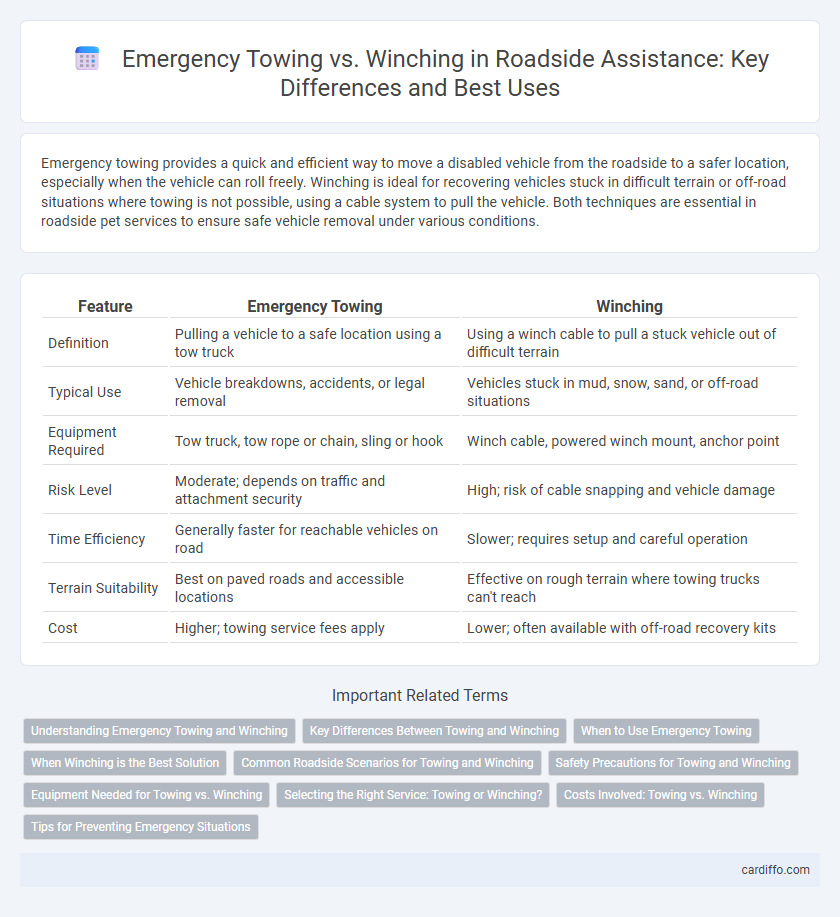Emergency towing provides a quick and efficient way to move a disabled vehicle from the roadside to a safer location, especially when the vehicle can roll freely. Winching is ideal for recovering vehicles stuck in difficult terrain or off-road situations where towing is not possible, using a cable system to pull the vehicle. Both techniques are essential in roadside pet services to ensure safe vehicle removal under various conditions.
Table of Comparison
| Feature | Emergency Towing | Winching |
|---|---|---|
| Definition | Pulling a vehicle to a safe location using a tow truck | Using a winch cable to pull a stuck vehicle out of difficult terrain |
| Typical Use | Vehicle breakdowns, accidents, or legal removal | Vehicles stuck in mud, snow, sand, or off-road situations |
| Equipment Required | Tow truck, tow rope or chain, sling or hook | Winch cable, powered winch mount, anchor point |
| Risk Level | Moderate; depends on traffic and attachment security | High; risk of cable snapping and vehicle damage |
| Time Efficiency | Generally faster for reachable vehicles on road | Slower; requires setup and careful operation |
| Terrain Suitability | Best on paved roads and accessible locations | Effective on rough terrain where towing trucks can't reach |
| Cost | Higher; towing service fees apply | Lower; often available with off-road recovery kits |
Understanding Emergency Towing and Winching
Emergency towing involves securing a disabled vehicle to a tow truck using a tow bar or hook to safely transport it from the roadside to a repair facility. Winching uses a powerful cable and winch mechanism to pull vehicles out of difficult or stuck situations, such as ditches or mud, without requiring the vehicle to be towed immediately. Understanding the specific conditions--like vehicle position, terrain, and damage severity--is crucial for deciding whether emergency towing or winching is the most effective roadside recovery method.
Key Differences Between Towing and Winching
Emergency towing involves pulling a disabled vehicle to a safe location using a tow truck, designed to move the vehicle over long distances or challenging terrain. Winching, by contrast, uses a cable and winch system to recover vehicles stuck in difficult situations, such as mud, ditches, or steep inclines, often requiring limited movement. The key differences lie in the purpose, equipment used, and the type of recovery: towing focuses on transport, while winching concentrates on extraction from immobilizing obstacles.
When to Use Emergency Towing
Emergency towing is essential when a vehicle is immobile due to mechanical failure or accident damage and must be transported safely to a repair facility without causing further harm. It is suitable for situations where the vehicle cannot be driven or winched out of difficult terrain, such as a ditch or mud, and requires immediate relocation on public roads. Choosing emergency towing ensures controlled, stable movement using a tow truck equipped with securing mechanisms, minimizing risks during transport.
When Winching is the Best Solution
Winching is the best solution when a vehicle is stuck in mud, snow, or uneven terrain where traditional towing cannot safely access or pull it out. It allows for controlled extraction by using a cable and pulley system anchored to a solid point, minimizing further damage to the vehicle. Emergency roadside services prioritize winching in off-road recovery scenarios due to its precision and effectiveness in challenging environments.
Common Roadside Scenarios for Towing and Winching
Emergency towing handles vehicles stranded on highways or after collisions, offering rapid transport to repair facilities. Winching excels in off-road or rugged environments where vehicles are stuck in mud, snow, or ditches, requiring controlled extraction. Both methods are essential for ensuring safety and efficient recovery in diverse roadside situations.
Safety Precautions for Towing and Winching
Safety precautions for emergency towing and winching include ensuring all equipment, such as tow straps and winch cables, are rated for the vehicle's weight to prevent failure. Always use gloves to protect hands from sharp cable frays and maintain a clear area to avoid injury from snapped lines or shifting loads. Proper attachment points on both vehicles must be used to avoid damage and ensure secure recovery during roadside towing or winching operations.
Equipment Needed for Towing vs. Winching
Emergency towing requires heavy-duty tow trucks equipped with a winch, towing cables, hooks, and sometimes a wheel-lift or flatbed system to safely secure and transport vehicles. Winching specifically relies on a powerful winch system, strong synthetic or steel cable, and secure anchor points such as trees or other vehicles to pull a stuck vehicle free. Both processes demand durable recovery gear including gloves, safety chains, and proper rigging hardware to ensure safe and effective roadside recovery operations.
Selecting the Right Service: Towing or Winching?
Selecting the right roadside assistance service between emergency towing and winching depends on the vehicle's condition and location. Emergency towing is ideal for severely immobilized vehicles or those involved in accidents, ensuring safe transport to a repair facility. Winching is preferable for vehicles stuck in mud, snow, or ditches, where extraction without full towing is sufficient and less costly.
Costs Involved: Towing vs. Winching
Emergency towing generally incurs higher costs than winching due to the complexity of transporting a vehicle to a repair facility or safe location. Winching involves pulling a vehicle from difficult positions, such as ditches or embankments, often requiring specialized equipment but usually at a lower price point because it does not include full transport. Factors like vehicle size, distance, and required equipment significantly influence the total cost of both towing and winching services.
Tips for Preventing Emergency Situations
Regular vehicle maintenance, such as checking tire pressure and brake functionality, significantly reduces the likelihood of needing emergency towing or winching. Keeping a roadside assistance kit, including traction mats and a portable air compressor, can prevent small issues from escalating. Familiarity with your vehicle's weight and clearance helps avoid situations requiring winching due to getting stuck or off-road mishaps.
Emergency towing vs winching Infographic

 cardiffo.com
cardiffo.com